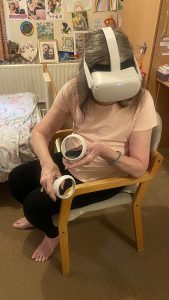When I did the interventions, I found that older people living in nursing homes have varying degrees of cognitive impairment, but understanding the cognitive state of older people is my knowledge boundary, so I searched the Internet, here are some of the information I got:
1. “In the large, population-based Canadian Study of Health and Aging, elderly people were classified as having one of the following conditions: no cognitive loss; cognitive impairment, no dementia; or dementia.

There is also controversy about the best way to objectively measure memory loss, whether by means of brief cognitive testing or a full neuropsychological evaluation.
Cognitive interventions Longitudinal cohort studies involving healthy elderly people have shown that engagement in stimulating cognitive activities (engaged lifestyle; novel and intellectually challenging activities) is associated with better memory and verbal abilities compared with people not engaging as much in such activities.86 Participation in intellectually stimulating and social activities in midlife has been associated with reduced risk of Alzheimer disease.”
Howard, C., Fadi, M., Ziad, N., Sylvie, B., Yves, J., Christian, B., Valérie, D., John, K., Morris, F., Howard, B. (2008) ‘Diagnosis and treatment of dementia: 3. Mild cognitive impairment and cognitive impairment without dementia’, Canadian Medical Association or its licensors, 178(10), pp. 1273–1285. DOI:10.1503/cmaj.070797
https://www.cmaj.ca/content/cmaj/178/10/1273.full.pdf
2. Mild cognitive impairment (MCI) is a clinical concept that identifies subjects who are in an intermediate state between normal aging and dementia.MCI is a syndrome characterized by an impairment of memory or another cognitive decline, which does not affect a person’s basic activities of daily living, whereas the complex instrumental functions may be minimally impaired. The clinical presentation, etiology, and outcome of MCI are heterogeneous (Petersen, 2004; Winblad et al., 2004). Most of the amnestic MCI patients have Alzheimer’s disease (AD) in a predementia stage (Albert et al., 2011) and progress to dementia at a rate of 10–15% yearly in comparison with approximately 1–2% a year in healthy older adults (Petersen et al., 2001).


Van der Mussele, S., Le Bastard, N., Vermeiren, Y., Saerens, J., Somers, N., Mariën, P., … & Engelborghs, S. (2013). ‘Behavioral symptoms in mild cognitive impairment as compared with Alzheimer’s disease and healthy older adults’. International journal of geriatric psychiatry, 28(3), pp. 265-275.
3. HoloLearn is a Mixed Reality (MR) application that exploits Microsoft HoloLens to help people with Cognitive Disability improve autonomy in everyday life.
A. Lay the Table

The purpose is to teach the user to lay a real table using virtual objects (e.g. glasses, plates, cutlery, or bottles), putting them in the proper position. The MR environment consists of the physical space surrounding the user (including a table the dimensions of which must be at least one meter per side, to guarantee enough space for the holograms) and the holographic elements: the virtual objects appear on one edge of the table and some highlighted areas on the other ones [Figure 1]. To complete the task, the user must “drag&drop” all the objects to the correct positions, corresponding to the highlighted areas.
B. Garbage Collection

The purpose is to help the user to learn how to perform garbage collection properly, identifying the various types of wastes such as plastic, paper and glass. The MR environment consists of the room where the user is located, different holographic bins (for paper, glass and plastic) are placed on the floor, and some holographic pieces of trash located nearby. The goal of the activity is to move each holographic trash object inside the correct bin, again exploiting the interaction modalities supported by HoloLens.
C. Virtual Assistant
In order to improve the user’s attention during the assigned tasks, HoloLearn includes a virtual character that provides step-by-step visual tooltips to the user to support her/him and promotes engagement and fun through movements, gestures and sound. According to the therapists, the virtual assistant should be a character familiar to the users. We considered different options and showed them to some people with CD; finally, we opted for a Minion, a movie character well-recognized and liked, especially by young people.
F. Garzotto, E. Torelli, F. Vona and B. Aruanno, “HoloLearn: Learning through Mixed Reality for People with Cognitive Disability,” 2018 IEEE International Conference on Artificial Intelligence and Virtual Reality (AIVR), 2018, pp. 189-190, doi: 10.1109/AIVR.2018.00042.
Then I try to contact them and ask my questions

At the same time, I contacted some neurologists and psychologists.

I only got a reply from a professor, and we also had a zoom meeting


I got some suggestions. First of all, if I want to get a test of the cognition of old age, I must first contact the Ethics Community. Regarding my question, will virtual reality technology have a positive impact on the elderly with dementia? The professor said that this topic is a relatively advanced topic and cannot be proved for the time being.


